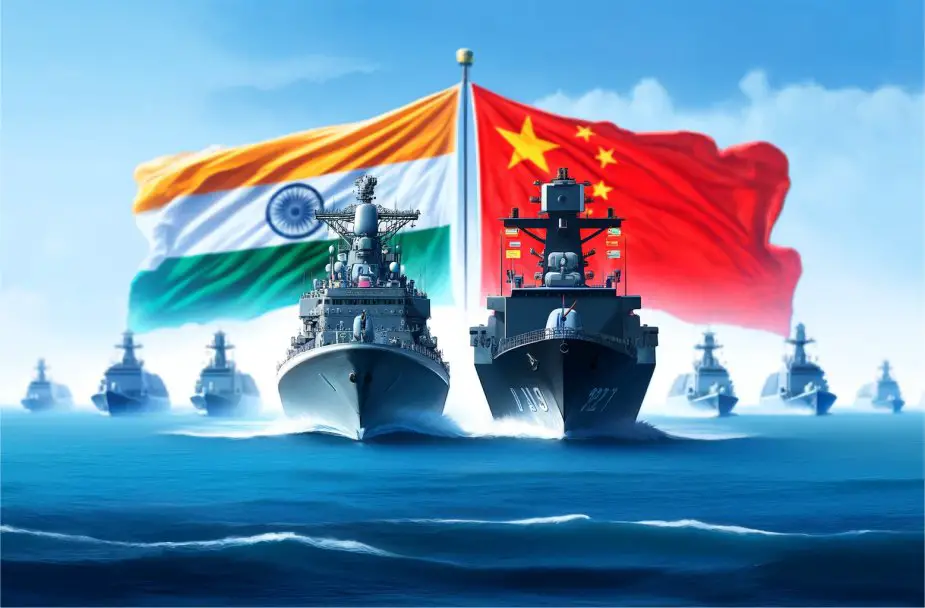According to information published by @somePLAOSINT on April 21, 2024, the Indian Navy and the People's Liberation Army Navy (PLAN) are each poised to significantly upgrade their naval capabilities through the commissioning of various classes of ships over the next few years.
Follow Navy Recognition on Google News at this link
 Artist rendering. (Picture source: Created by IA)
Artist rendering. (Picture source: Created by IA)
The Indian Navy's ship commissioning schedule includes key additions designed to update its naval capabilities. In 2024, the Indian Navy will commission one Project 15B Visakhapatnam-class destroyer and one Project 17A Nilgiri-class frigate, alongside two Talwar-class frigates.
The Project 15B destroyer, with a displacement of 7,400 tons and length of 163 meters, is equipped with BrahMos surface-to-surface missiles, Medium Range Surface-to-Air Missiles, a 76mm Super Rapid Gun Mount, and Anti-Submarine Rocket Launchers, and has features designed to reduce radar cross-section.
The Project 17A frigates, displacing 6,670 tons and measuring 149 meters in length, are armed with BrahMos supersonic cruise missiles, Barak-8 surface-to-air missiles, a 76mm main gun, and have anti-aircraft and anti-submarine capabilities, also incorporating radar-absorbing materials for stealth.
PLA Navy
In contrast, the PLAN's commissioning plans from 2024 to 2026 indicate a significant increase in both the number and diversity of vessels. The PLAN is set to commission one Type 052D destroyer and two Type 054B frigates in 2024.
The Type 052D destroyers have a displacement of approximately 7,500 tons and a length of 157 meters, featuring a 64-cell vertical launching system for a variety of missiles, a 130mm dual-purpose gun, and anti-submarine capabilities.
The Type 054B frigates, while specific details are less clear, are expected to continue the advancements seen in previous frigate designs with updated armaments and sensors.
In 2025, the PLAN's schedule includes the commissioning of a Type 003 aircraft carrier, a Type 075 landing helicopter dock, and additional destroyers and frigates. The Type 003 carrier, estimated to displace about 85,000 tons and over 300 meters in length, represents a major step forward in capabilities with a CATOBAR system to support a wider range of aircraft operations.
The Type 075 landing helicopter dock, displacing about 40,000 tons and 250 meters in length, is designed to support amphibious operations, equipped to transport numerous helicopters, vehicles, and troops.
By 2026, the PLAN will add more Type 055 and Type 052D destroyers to its fleet. The Type 055 destroyers, with a displacement of about 13,000 tons and a length of 180 meters, are heavily armed with a 112-cell vertical launch system and integrated with advanced radar and sonar systems.
Analysis
The Indian Navy’s commissioning plan reflects a focused enhancement of its surface warfare and anti-submarine capabilities. By introducing advanced destroyers and frigates, such as the Project 15B and Project 17A, alongside the continued addition of Talwar-class frigates, India is addressing specific needs for regional maritime security and safeguarding its interests in the Indian Ocean.
These ships are equipped with state-of-the-art weaponry and stealth technologies that aim to ensure the Indian Navy remains versatile in multi-theater operations, particularly in a region frequented by maritime piracy and territorial disputes. This strategic focus not only aims to secure critical sea lanes that are vital for India's economic interests but also serves as a deterrent against potential regional adversaries.
In contrast, the PLAN’s commissioning activities signal a more expansive approach. The introduction of diverse and powerful vessels such as the Type 052D destroyers, Type 054B frigates, Type 003 aircraft carrier, and Type 075 landing helicopter docks illustrates China’s intention to project its maritime power well beyond its immediate regional waters.
This strategy is indicative of China’s ambitions to establish itself as a dominant blue-water navy capable of sustaining long-range operations across multiple oceans. The commissioning of the Type 003 aircraft carrier, in particular, marks a significant development in China's naval capabilities, providing it with the ability to project air power globally, an essential component for achieving blue-water status.
Moreover, the Type 075 ships enhance the amphibious assault capabilities, facilitating rapid deployment and support of ground forces in distant theaters, which could be crucial in scenarios involving island or coastal conflicts.
By 2026, the addition of more Type 055 and Type 052D destroyers will considerably strengthen the PLAN’s surface combatant fleet, reinforcing its layered defense and offense capabilities across a broad spectrum of maritime operations.
These ships are not only heavily armed but also incorporate advanced electronic warfare and missile systems, making them formidable opponents in both anti-air and missile defense roles. Such capabilities are crucial for maintaining operational superiority in contested areas such as the South China Sea and the broader Pacific region.
The contrasting approaches of the Indian Navy and the PLAN underscore their respective national security priorities. India’s strategy appears more concentrated on defending and asserting its influence in the Indian Ocean, fostering stability in a region critical to its economic prosperity.
Conversely, China's strategy is evidently geared towards expanding its influence as a global maritime power, capable of projecting military strength across critical international waters, thereby supporting its broader strategic interests and asserting its claims in contested maritime regions. This dual focus on regional dominance and global presence positions China at a pivotal point in shaping.



